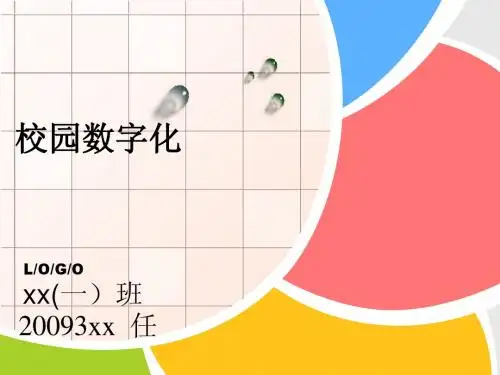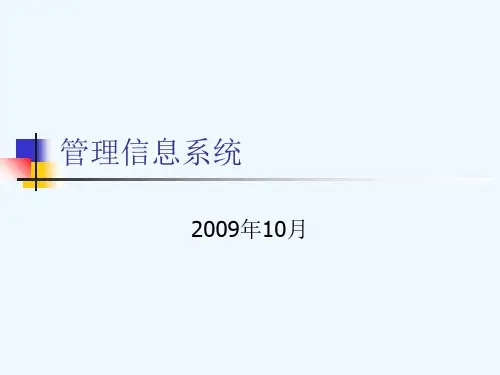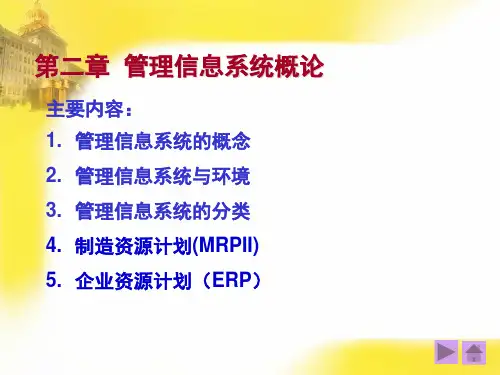管理信息系统 mis教案第二章PPT课件
- 格式:ppt
- 大小:332.00 KB
- 文档页数:17

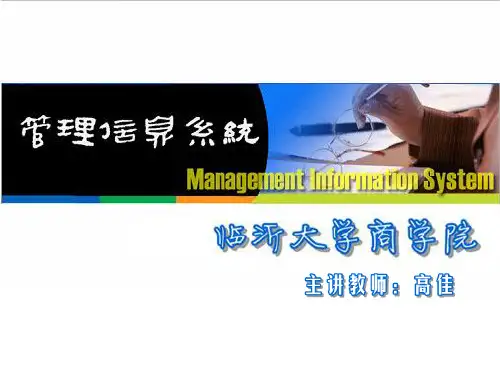
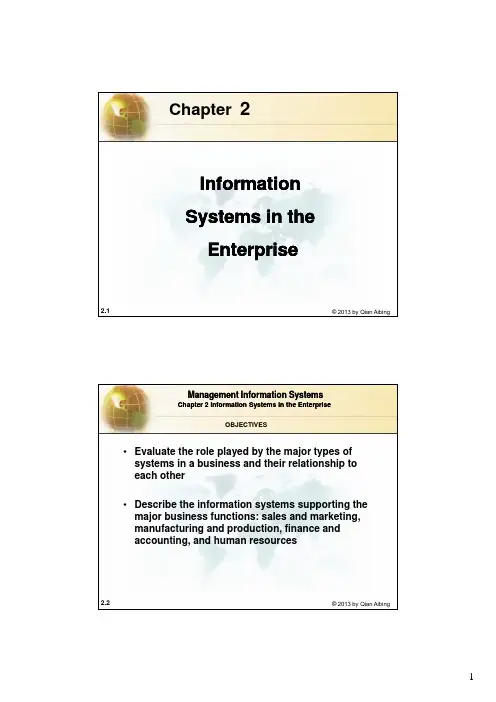
2Chapter InformationSystems in the2.1©2013 by Qian AibingEnterpriseOBJECTIVES•Evaluate the role played by the major types of Management Information SystemsChapter 2 Information Systems in the Enterprisesystems in a business and their relationship to each other•Describe the information systems supporting the major business functions: sales and marketing, manufacturing and production, finance and 2.2©2013 by Qian Aibinggaccounting, and human resources•Analyze the relationship between organizations, Management Information SystemsChapter 2 Information Systems in the EnterpriseOBJECTIVES (continued)information systems, and business processes•Explain how enterprise applications promote business process integration and improveorganizational performance2.3©2013 by Qian Aibing•Assess the challenges posed by information systems in the enterprise and managementsolutions•Challenge:monthly changes in fashions; Mango has Management Information SystemsChapter 2 Information Systems in the EnterpriseMango Case: Fast Fashion, Hot Systems731 stores in 72 countries•Solutions. Inventory replenishment system tracks all sales and matches stores with inventory.•Design teams meet weekly to adjust to trends.•Distribution system allocates bar-coded items to 2.4©2013 by Qian AibingDistribution system allocates bar coded items to specific stores based on store/product mix.•Reduces time to market, increases agility•Increases accuracy of decision makingManagement Information SystemsChapter 2 Information Systems in the EnterpriseMAJOR TYPES OF SYSTEMS IN ORGANIZATIONSTypes of Information Systems2.5©2013 by Qian AibingFigure 2-1Management Information SystemsChapter 2 Information Systems in the EnterpriseMAJOR TYPES OF SYSTEMS IN ORGANIZATIONSDifferent Kinds of SystemsThree main categories of information systems serve1.Operational-level systems:support operational managers,keeping track of the elementary activities andtransactions2.Management-level systems:serve the monitoring,Three main categories of information systems serve different organizational levels:2.6©2013 by Qian Aibingcontrolling, decision-making, and administrative activities3.Strategic-level systems:help senior management tackleand address strategic issuesManagement Information SystemsChapter 2 Information Systems in the EnterpriseMAJOR TYPES OF SYSTEMS IN ORGANIZATIONSMajor Types of Systems•Transaction Processing Systems (TPS)•Management Information Systems (MIS)•Decision-Support Systems (DSS)•Executive Support Systems (ESS)2.7©2013 by Qian AibingManagement Information SystemsChapter 2 Information Systems in the EnterpriseMAJOR TYPES OF SYSTEMS IN ORGANIZATIONSThe Four Major Types of Information SystemsFigure 2-22.8©2013 by Qian AibingManagement Information SystemsChapter 2 Information Systems in the EnterpriseMAJOR TYPES OF SYSTEMS IN ORGANIZATIONSTransaction Processing Systems (TPS)•Basic business systems that serve theoperational level• A computerized system that performs andrecords the daily routine transactions necessary 2.9©2013 by Qian Aibingrecords the daily routine transactions necessary to the conduct of the businessManagement Information SystemsChapter 2 Information Systems in the EnterpriseMAJOR TYPES OF SYSTEMS IN ORGANIZATIONSA Symbolic Representation for a Payroll TPS2.10©2013 by Qian AibingFigure 2-3Management Information SystemsChapter 2 Information Systems in the EnterpriseMAJOR TYPES OF SYSTEMS IN ORGANIZATIONSTypical Applications of TPS2.11©2013 by Qian AibingFigure 2-4Management Information SystemsChapter 2 Information Systems in the EnterpriseMAJOR TYPES OF SYSTEMS IN ORGANIZATIONSManagement Information Systems (MIS)M t l lManagement level •Inputs:High volume transaction level data •Processing:Simple modelsSummary reports2.12©2013 by Qian Aibing•Outputs:Summary reports •Users:Middle managersExample: Annual budgetingManagement Information SystemsChapter 2 Information Systems in the EnterpriseMAJOR TYPES OF SYSTEMS IN ORGANIZATIONSManagement Information Systems (MIS) (continued)Figure 2-52.13©2013 by Qian AibingManagement Information SystemsChapter 2 Information Systems in the EnterpriseMAJOR TYPES OF SYSTEMS IN ORGANIZATIONSManagement Information Systems (MIS)(continued)p pA sample MIS reportFigure 2-62.14©2013 by Qian AibingManagement Information SystemsChapter 2 Information Systems in the EnterpriseMAJOR TYPES OF SYSTEMS IN ORGANIZATIONSDecision-Support Systems (DSS)Management levelManagement level •Inputs:Transaction level data•Processing:Interactive2.15©2013 by Qian Aibing•Outputs:Decision analysis•Users:Professionals, staffExample: Contract cost analysisManagement Information SystemsChapter 2 Information Systems in the EnterpriseMAJOR TYPES OF SYSTEMS IN ORGANIZATIONSDecision-Support Systems (DSS) (Continued)Voyage-estimating decision-support system y g g pp y2.16©2013 by Qian AibingFigure 2-7Management Information SystemsChapter 2 Information Systems in the EnterpriseMAJOR TYPES OF SYSTEMS IN ORGANIZATIONSEXECUTIVE SUPPORT SYSTEMS (ESS):•Inputs:Aggregate data•Processing:Interactive•Outputs:Projections 2.17©2013 by Qian Aibingp j•Users:Senior managersExample: 5 year operating planManagement Information SystemsChapter 2 Information Systems in the EnterpriseMAJOR TYPES OF SYSTEMS IN ORGANIZATIONSModel of a Typical Executive Support System2.18©2013 by Qian AibingFigure 2-8Management Information SystemsChapter 2 Information Systems in the EnterpriseMAJOR TYPES OF SYSTEMS IN ORGANIZATIONSEXECUTIVE SUPPORT SYSTEMS (ESS)(Continued)•Top Level Management•Designed to the individual senior manager •Ties CEO to all levels2.19©2013 by Qian Aibing•Very expensive to keep up•Extensive support staffManagement Information SystemsChapter 2 Information Systems in the EnterpriseMAJOR TYPES OF SYSTEMS IN ORGANIZATIONSRelationship of Systems to One AnotherInterrelationships among systems2.20©2013 by Qian AibingFigure 2-9Management Information SystemsChapter 2 Information Systems in the EnterpriseMAJOR TYPES OF SYSTEMS IN ORGANIZATIONSRelationship of Systems to One AnotherIn contemporary digital firms, the different types of systems are closely linked to one another. This is the ideal. In traditional firms these systems tend to be isolated from one another, and information does not flow seamlessly from one end of the organization to the other. Efficiency and business value tend to 2.21©2013 by Qian Aibingysuffer greatly in these traditional firmsManagement Information SystemsChapter 2 Information Systems in the EnterpriseSYSTEMS FROM A FUNCTIONAL PERSPECTIVESales and Marketing SystemsMajor functions of systems:•Sales management, market research, promotion, pricing, new productsMajor application systems:2.22©2013 by Qian Aibing•Sales order info system, market research system, pricing systemManagement Information SystemsChapter 2 Information Systems in the EnterpriseSYSTEMS FROM A FUNCTIONAL PERSPECTIVESales and Marketing SystemsSYSTEM DESCRIPTION ORGANIZATIONALSYSTEM DESCRIPTION ORGANIZATIONAL LEVELOrder processingEnter, process, and track orders Operational Pricing analysis Determine prices for products and Management 2.23©2013 by Qian Aibingc g a a ys s ete e p ces o p oducts ad servicesa age e tSales trend forecastingPrepare 5-year sales forecasts Strategic Table 2-2Management Information SystemsChapter 2 Information Systems in the EnterpriseSYSTEMS FROM A FUNCTIONAL PERSPECTIVEManufacturing and Production SystemsMajor functions of systems:•Scheduling, purchasing, shipping, receiving, engineering, operationsMajor application systems:2.24©2013 by Qian Aibing•Materials resource planning systems, purchase order control systems, engineering systems,quality control systemsManagement Information SystemsChapter 2 Information Systems in the EnterpriseSYSTEMS FROM A FUNCTIONAL PERSPECTIVEDESCRIPTION ORGANIZATIONALManufacturing and Production SystemsSYSTEM DESCRIPTION ORGANIZATIONAL LEVELMachine control Control the actions of machines and equipmentOperational Production Decide when and how many products 2.25©2013 by Qian AibingProduction planning Decide when and how many products should be producedManagement Facilities location Decide where to locate new production facilitiesStrategic Management Information SystemsChapter 2 Information Systems in the EnterpriseOverview of an Inventory SystemSYSTEMS FROM A FUNCTIONAL PERSPECTIVE2.26©2013 by Qian AibingFigure 2-10Management Information SystemsChapter 2 Information Systems in the EnterpriseSYSTEMS FROM A FUNCTIONAL PERSPECTIVEFinancing and Accounting SystemsMajor functions of systems:•Budgeting, general ledger, billing, costaccountingMajor application systems:2.27©2013 by Qian Aibing•General ledger, accounts receivable, accounts payable, budgeting, funds management systemsManagement Information SystemsChapter 2 Information Systems in the EnterpriseSYSTEMS FROM A FUNCTIONAL PERSPECTIVEFinancing & Accounting Systems (Continued)SYSTEM DESCRIPTION ORGANIZATION-AL LEVELAccounts receivableTracks money owed the firm Operational2.28©2013 by Qian AibingBudgeting Prepares short-term budgets ManagementProfit planningPlans long-term profits StrategicTable 2-4Management Information SystemsChapter 2 Information Systems in the EnterpriseSYSTEMS FROM A FUNCTIONAL PERSPECTIVEHuman Resource SystemsMajor functions of systems:•Personnel records, benefits, compensation, labor relations, trainingMajor application systems:2.29©2013 by Qian Aibing•Payroll, employee records, benefit systems,career path systems, personnel training systemsManagement Information SystemsChapter 2 Information Systems in the EnterpriseSYSTEMS FROM A FUNCTIONAL PERSPECTIVEHuman Resource Systems (Continued)SYSTEM DESCRIPTION ORGANIZATIONALLEVELTraining and development Tracks employee training, skills, and performance appraisalsOperational Compensation Monitors the range and distribution of employee wages salaries andManagement 2.30©2013 by Qian Aibinganalysis of employee wages, salaries, and benefitsHuman resources planning Plans the long-term labor force needs of the organizationStrategic Table 2-5Management Information SystemsChapter 2 Information Systems in the EnterpriseHuman Resource Systems (Continued) An Employee Recordkeeping SystemSYSTEMS FROM A FUNCTIONAL PERSPECTIVE2.31©2013 by Qian AibingFigure 2-11Management Information SystemsChapter 2 Information Systems in the EnterpriseBusiness Processes and Information Systems B iINTEGRATING FUNCTIONS AND BUSINESS PROCESSES:Introduction to Enterprise ApplicationsBusiness processes:•Manner in which work is organized, coordinated, and focused to produce a valuable product or service•Concrete work flows of material, information, and knowledge——sets of activities2.32©2013 by Qian Aibingknowledge sets of activities •Unique ways to coordinate work, information, and knowledge•Ways in which management chooses tocoordinate workManagement Information SystemsChapter 2 Information Systems in the EnterpriseBusiness Processes and Information SystemsINTEGRATING FUNCTIONS AND BUSINESS PROCESSES:Introduction to Enterprise Applications(Continued)•Information systems help organizationsachieve great efficiencies by automating parts of processes•IS also contributes to completely rethinking 2.33©2013 by Qian Aibingy g processes.•Business processes typically span several different functional areas.Management Information SystemsChapter 2 Information Systems in the EnterpriseExamples of Business ProcessesINTEGRATING FUNCTIONS AND BUSINESS PROCESSES:Introduction to Enterprise ApplicationsManufacturing and production:•Assembling product, checking quality, producing bills of materialsSales and marketing:2.34©2013 by Qian Aibing•Identifying customers, creating customer awareness, sellingTable 2.6Management Information SystemsChapter 2 Information Systems in the EnterpriseINTEGRATING FUNCTIONS AND BUSINESS PROCESSES:Introduction to Enterprise ApplicationsExamples of Business Processes (Continued)Finance & accounting Finance & accounting:•Paying creditors, creating financial statements, managing cash accountsH Examples of Business Processes (Continued)2.35©2013 by Qian AibingHuman resources Human resources:•Hiring employees, evaluating performance, enrolling employees in benefits plansTable 2.6 continuedManagement Information SystemsChapter 2 Information Systems in the EnterpriseBusiness Processes and Information Systems INTEGRATING FUNCTIONS AND BUSINESS PROCESSES:Introduction to Enterprise ApplicationsCross Cross--Functional Business Processes:•Transcend boundary between sales, marketing, manufacturing, and research and development 2.36©2013 by Qian Aibing•Group employees from different functional specialties to a complete piece of workExample: Order Fulfillment ProcessManagement Information SystemsChapter 2 Information Systems in the EnterpriseThe Order Fulfillment ProcessINTEGRATING FUNCTIONS AND BUSINESS PROCESSES:Introduction to Enterprise Applications2.37©2013 by Qian AibingFigure 2-12Management Information SystemsChapter 2 Information Systems in the EnterpriseSystems for Enterprise-Wide Process Integration INTEGRATING FUNCTIONS AND BUSINESS PROCESSES:Introduction to Enterprise ApplicationsEnterprise applications:•Designed to support organization Designed to support organization--wide process coordination and integration2.38©2013 by Qian AibingManagement Information SystemsChapter 2 Information Systems in the EnterpriseSystems for Enterprise-Wide Process IntegrationINTEGRATING FUNCTIONS AND BUSINESS PROCESSES:Introduction to Enterprise ApplicationsConsist ofConsist of :•Enterprise systems•Supply chain management systems•Customer relationship management systems (Continued)2.39©2013 by Qian Aibing•Knowledge management systemsManagement Information SystemsChapter 2 Information Systems in the EnterpriseEnterprise SystemsINTEGRATING FUNCTIONS AND BUSINESS PROCESSES:Introduction to Enterprise Applications•Enterprise systems, also known as enterprise resource planning (ERP) systems, provide asingle information system for organization single information system for organization--wide coordination and integration of key business processes.2.40©2013 by Qian Aibing•Information that was previously fragmented indifferent systems can seamlessly flow throughout the firm so that it can be shared by businessprocesses in manufacturing, accounting, human resources, and other areas.Management Information SystemsChapter 2 Information Systems in the EnterpriseEnterprise Application ArchitectureINTEGRATING FUNCTIONS AND BUSINESS PROCESSES:Introduction to Enterprise Applications2.41©2013 by Qian AibingFigure 2-13Management Information SystemsChapter 2 Information Systems in the EnterpriseTraditional “Silo” View of Information Systems INTEGRATING FUNCTIONS AND BUSINESS PROCESSES:Introduction to Enterprise ApplicationsWithin the business:•There are functions, each having its uses of information systemsOutside the organization’s boundaries:2.42©2013 by Qian Aibing•There are customers and vendorsFunctions tend to work in isolationManagement Information SystemsChapter 2 Information Systems in the EnterpriseTraditional View of SystemsINTEGRATING FUNCTIONS AND BUSINESS PROCESSES:Introduction to Enterprise Applications2.43©2013 by Qian AibingFigure 2-14Management Information SystemsChapter 2 Information Systems in the EnterpriseEnterprise SystemsINTEGRATING FUNCTIONS AND BUSINESS PROCESSES:Introduction to Enterprise Applications2.44©2013 by Qian AibingFigure 2-15Management Information SystemsChapter 2 Information Systems in the EnterpriseBenefits of Enterprise SystemsINTEGRATING FUNCTIONS AND BUSINESS PROCESSES:Introduction to Enterprise Applications•Help to unify the firm’s structure and organization:One organization•Management:Firm wide knowledge Firm wide knowledge--basedmanagement processes2.45©2013 by Qian Aibing•Technology:Unified platform•Business:More efficient operations & customer More efficient operations & customer--driven business processesManagement Information SystemsChapter 2 Information Systems in the EnterpriseChallenges of Enterprise SystemsINTEGRATING FUNCTIONS AND BUSINESS PROCESSES:Introduction to Enterprise Applications•Difficult to build:Require fundamental changes in the way the business operates•Technology:Require complex pieces of software and large investments of time, money, and2.46©2013 by Qian Aibingexpertise•Centralized organizational coordination anddecision making:Not the best way for the firms to operateManagement Information SystemsChapter 2 Information Systems in the EnterpriseSupply Chain Management (SCM)Close linkage and coordination of activitiesINTEGRATING FUNCTIONS AND BUSINESS PROCESSES:Introduction to Enterprise Applications•Close linkage and coordination of activities involved in buying, making, and moving aproduct•Integrates supplier, manufacturer, distributor, and customer logistics time2.47©2013 by Qian Aibing•Reduces time, redundant effort, and inventory costs•Network of organizations and businessprocessesManagement Information SystemsChapter 2 Information Systems in the EnterpriseH l i t f t i lSupply Chain Management (SCM)INTEGRATING FUNCTIONS AND BUSINESS PROCESSES:Introduction to Enterprise Applications•Helps in procurement of materials, transformation of raw materials into intermediate and finished products•Helps in distribution of the finished products to customers2.48©2013 by Qian Aibing•Includes reverse logistics Includes reverse logistics --returned items flow in the reverse direction from the buyer back to the sellerManagement Information SystemsChapter 2 Information Systems in the EnterpriseHaworth’s Supply Chain Management SystemsINTEGRATING FUNCTIONS AND BUSINESS PROCESSES:Introduction to Enterprise Applications2.49©2013 by Qian AibingFigure 2-16Management Information SystemsChapter 2 Information Systems in the EnterpriseInformation from Supply Chain ManagementSystems helps firms:INTEGRATING FUNCTIONS AND BUSINESS PROCESSES:Introduction to Enterprise ApplicationsSystems helps firms: •Decide when and what to produce, store,and move•Rapidly communicate orders2.50©2013 by Qian Aibing•Track the status of orders•Check inventory availability and monitorinventory levelsManagement Information SystemsChapter 2 Information Systems in the EnterpriseInformation from Supply Chain ManagementSystems helps firms:(Continued)INTEGRATING FUNCTIONS AND BUSINESS PROCESSES:Introduction to Enterprise ApplicationsSystems helps firms: (Continued)•Reduce inventory, transportation, andwarehousing costs•Track shipments2.51©2013 by Qian Aibing•Plan production based on actual customerdemand•Rapidly communicate changes in product designManagement Information SystemsChapter 2 Information Systems in the EnterpriseCustomer Relationship Management (CRM)INTEGRATING FUNCTIONS AND BUSINESS PROCESSES:Introduction to Enterprise Applications•Manages all ways used by firms to deal with existing and potential new customers•Business and technology discipline2.52©2013 by Qian Aibing•Uses information system to coordinate entire business processes of a firmManagement Information SystemsChapter 2 Information Systems in the EnterpriseCustomer Relationship Management (CRM)(Continued)INTEGRATING FUNCTIONS AND BUSINESS PROCESSES:Introduction to Enterprise Applications(Continued)•Provides end Provides end--to to--end customer care•Provides a unified view of customer across the company2.53©2013 by Qian Aibing•Consolidates customer data from multiplesources and provides analytical tools foranswering questionsManagement Information SystemsChapter 2 Information Systems in the EnterpriseCustomer Relationship Management (CRM)INTEGRATING FUNCTIONS AND BUSINESS PROCESSES:Introduction to Enterprise Applications2.54©2013 by Qian AibingFigure 2-17Management Information SystemsChapter 2 Information Systems in the EnterpriseKnowledge Management SystemsINTEGRATING FUNCTIONS AND BUSINESS PROCESSES:Introduction to Enterprise Applications•Collects relevant knowledge and make it available wherever and whenever it is needed•Support business processes and management decisionsAlso link the firm to external sources of2.55©2013 by Qian Aibing•Also link the firm to external sources of knowledge•Support processes for acquiring, storing,distributing, and applying knowledgeManagement Information SystemsChapter 2 Information Systems in the EnterpriseMANAGEMENT OPPORTUNITIES, CHALLENGES, ANDSOLUTIONSManagement Opportunities:•There are extraordinary opportunities to use information systems to achieve business value, and increase profitability2.56©2013 by Qian AibingManagement Information SystemsChapter 2 Information Systems in the EnterpriseMANAGEMENT OPPORTUNITIES, CHALLENGES, ANDSOLUTIONSManagement Challenges:•Integration and the whole firm view:Given the different interests and perspectives within a firm, it is difficult to achieve consensus about the need for the "whole firm" viewpoint.Management and employee training:Training a 2.57©2013 by Qian Aibing•Management and employee training:Training a large number of employees on many systems in a large organization involves commensurately large investments.Management Information SystemsChapter 2 Information Systems in the EnterpriseMANAGEMENT OPPORTUNITIES, CHALLENGES, ANDSOLUTIONSManagement Challenges: (Continued)•Accounting for the cost of systems and managing demands for systems:Given the large number of different types of systems in a firm, and the large number of people involved with using them it is g g ()2.58©2013 by Qian Aibingnumber of people involved with using them, it is a complex task to understand which systems are truly necessary and productive with high returns on investmentManagement Information SystemsChapter 2 Information Systems in the EnterpriseMANAGEMENT OPPORTUNITIES, CHALLENGES, ANDSOLUTIONSSolution Guidelines:•Inventory the firm’s information systems: Develop a list of firm a list of firm--wide information requirements to give a 360a 360--degree view of the most importantinformation needs of the firm.•Employee and management education:Ensure that 2.59©2013 by Qian Aibingp y g you understand how much training is required.•Account for the costs and benefits: Develop an accounting system for information services firm accounting system for information services firm--wide.。
